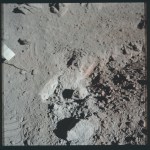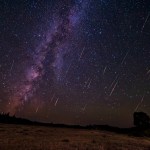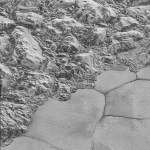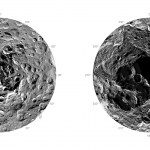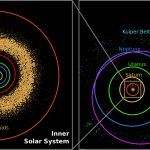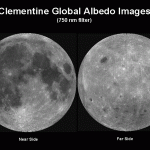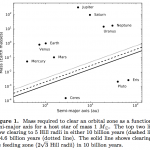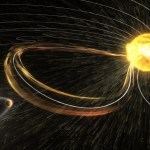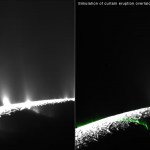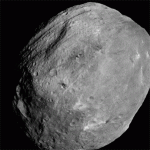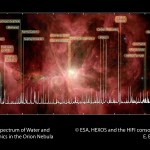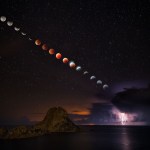Solar System
"It's like trying to describe what you feel when you're standing on the rim of the Grand Canyon or remembering your first love or the birth of your child. You have to be there to really know what it's like." -Harrison Schmitt
They say that one of the most exciting phrases to hear in science is not "eureka!" but "that's funny," and the Apollo 17 astronauts, just over 43 years ago, certainly got such a moment when they discovered orange soil just beneath the grey regiolith.
Image credit: NASA / Apollo 17.
What turned out to be volcanic glass with tin inclusions had another surprise: olivine…
“You are the salt of the earth. But remember that salt is useful when in association, but useless in isolation.” -Israelmore Ayivor
When NASA's Dawn spacecraft began photographing Ceres, one big surprise emerged: the presence of a spectacularly and unusually bright spot at the bottom of Occator crater. As we got closer, we discovered it was a series of spots in the lowlands of the crater bed, and that there were other suspicious, smaller bright spots elsewhere on the surface.
Image credit: NASA/JPL-Caltech/UCLA/MPS/DLR/IDA, converted from Nature Publishing Group press’s YouTube channel.…
"Mars is much closer to the characteristics of Earth. It has a fall, winter, summer and spring. North Pole, South Pole, mountains and lots of ice. No one is going to live on Venus; no one is going to live on Jupiter." -Buzz Aldrin
When we think about life in the Universe, we think about Earth-like conditions: a hospitable atmosphere devoid of poison, flowing water and the right temperatures and pressures for liquid on the surface, and just the right distance from the parent star to make it all happen. But perhaps life exists in abundance under very different conditions: in the atmospheres of…
“Every moment of light and dark is a miracle.” -Walt Whitman
Every once in a while, the Earth hurtles through the orbital path of a comet or asteroid, with the Sun having torn tiny bits of debris from the parent body. As a result, the Earth strikes these dusty fragments at speeds often exceeding a hundred thousand miles-per-hour, resulting in a tremendous light show: meteor showers!
Image credit: NASA / public domain, of the Leonid meteor shower (1997) as seen from space.
Most people wind up disappointed in meteor showers for two reasons: they don't know what to expect and they don't…
"We've learned that the view of four inner rocky planets and four outer gas giants and one misfit Pluto is wrong. Now we understand Pluto's context." -Alan Stern
After a 9 year journey to Pluto, NASA's New Horizons spacecraft made its closest approach to Pluto this past July, taking so much data that it will take a full 16 months to send it all back. The first of the highest resolution photos ever taken were released by NASA earlier today.
Image credit: NASA/JHUAPL/SwRI.
Even though the data has yet to be scientifically analyzed, a visual inspection teaches us a number of things about…
"Lots of science fiction deals with distant times and places. Intrepid prospectors in the Asteroid Belt. Interstellar epics. Galactic empires. Trips to the remote past or future." -Edward M. Lerner
Of all the asteroids we've ever discovered, it's arguably the very first one, Ceres, that's got the most to teach us. Currently being mapped at higher and higher resolution by NASA's Dawn Spacecraft, Ceres isn't just the largest asteroid we've got, it's also one of the least inclined, orbiting the Sun with a tilt of just 3 degrees.
Image credit: NASA / JPL-Caltech / UCLA / MPS / DLR / IDA, from…
"We are not like the social insects. They have only the one way of doing things and they will do it forever, coded for that way. We are coded differently, not just for binary choices, go or no-go. We can go four ways at once, depending on how the air feels: go, no-go, but also maybe, plus what the hell let's give it a try." -Lewis Thomas
One of the most important characteristics of a planet, at least according to the IAU definition, is that it clear its orbit of all other bodies. But if we allowed for a special caveat -- the possibility of two similarly-sized objects sharing the same orbit…
"Learn from yesterday, live for today, hope for tomorrow. The important thing is not to stop questioning." -Albert Einstein
While it's easy to look on Einstein's general theory of relativity — which turns 100 today — as a revolutionary new way to interpret space and time, as well as their interplay with matter and energy, it actually came about due to a problem with the Solar System.
Image credit: NASA / JPL-Caltech / R. Hurt.
The orbits of all the planets, comets and asteroids were explained very nicely by Newtonian gravity, with the exception of Mercury, which precessed a little too…
“Cheap little rhymes
A cheap little tune
Are sometimes as dangerous
As a sliver of the moon.” -Langston Hughes
4.5 billion years ago, a giant object collided with our proto-Earth, kicking up debris that eventually coalesced into the Moon.
Image credit: NASA/JPL-Caltech.
While the near side contains dark maria and lunar lowlands, the far side is almost exclusive heavily cratered, high-mountainous regions. This was a mystery for a long time, but it appears that heating from the hot, young Earth caused a chemical and crustal difference between the two faces.
Images credit: NASA / JPL-Caltech…
"There are still so many questions to answer. When you look at any part of the universe, you have to feel humbled." -Saul Perlmutter
Discovered in 1998 from the observation of distant supernovae, dark energy determines the eventual fate of the Universe, leading to a "Big Freeze" scenario, where all the galaxies, groups and clusters that are presently gravitationally unbound from one another will eventually recede away until they're unreachable.
Image credit: NASA & ESA, via http://www.spacetelescope.org/images/opo9919k/.
But if dark energy truly permeates all of space as a…
"Some kind of celestial event. No — no words. No words to describe it. Poetry! They should have sent a poet. So beautiful. So beautiful... I had no idea." -Dr. Ellie Arroway, Contact
Back in 2006, the International Astronomical Union defined the term "planet" for the first time by three criteria: its ability to orbit the Sun, to pull itself into hydrostatic equilibrium, and to clear its orbit. This not only excluded all exoplanets, but it set up impractical criteria for measuring exoplanet properties.
Image credit: ESO.
But UCLA scientist Jean-Luc Margot found a new planetary test…
"Studying whether there's life on Mars or studying how the universe began, there's something magical about pushing back the frontiers of knowledge. That's something that is almost part of being human, and I'm certain that will continue." -Sally Ride
If you came to the Solar System some 500 million years after its formation, you would've found two world with oceans of liquid water, continents and all the conditions we know of for life to begin thriving: Earth and Mars. But unlike our own world, Mars' organic history was cut short when it lost its atmosphere and became a barren, desert…
"This scenario implies that the giant planet instability is not the source of the Late Heavy Bombardment and that terrestrial planet formation finished with the giant planets in their modern configuration." -Nathan A. Caib & John E. Chambers
It's a common but nonetheless spectacular occurrence when our leading scientific theories -- the ones with the best explanations for the observed phenomena -- run into conflict with what we see. Sometimes, it's the power of simulations that show us the way.
In 2005, scientists put forth the "Nice Model" to explain the configuration of the Solar…
“When you arise in the morning, think of what a precious privilege it is to be alive — to breathe, to think, to enjoy, to love.” -Marcus Aurelius
How old is life on Earth? If all you had to go on was the fossil record, you'd run into severe trouble once you went back more than one or two billion years, as all your rock would have metamorphosed, making examination and identification of fossils impossible. But recently, we've discovered another method: to measure the isotopic content of carbon deposits in ancient rock formations.
Image credit: E A Bell et al, Proc. Natl. Acad. Sci. USA,…
“My Lord, the fleet has moved out of lightspeed. Com Scan has detected an energy field protecting an area of the sixth planet of the Hoth System. The field is strong enough to deflect any bombardment.” -General Veers, Star Wars: The Empire Strikes Back
Out beyond Saturn’s main rings lie a number of prominent moons: Titan, Dione, Rhea, and the subject of today’s post, Enceladus, the whitest, most reflective moon of all.
Image credit: NASA / Cassini-Huygens mission / Imaging Science Subsystem.
Unlike all the other moons in our Solar System, Enceladus’ most unique features is its active…
“I have announced this star as a comet, but since it is not accompanied by any nebulosity and, further, since its movement is so slow and rather uniform, it has occurred to me several times that it might be something better than a comet. But I have been careful not to advance this supposition to the public.” –Giuseppe Piazzi, discoverer of Ceres, the first Asteroid
While it's always fascinating to look far, far out into the cosmos, it's important to remember that there are plenty of questions close to home -- about our own Solar System, for instance -- that we still don't know the answer to.…
“If I had to describe myself to an alien I’d say I was bigger than the average human, enjoy a drink or two with a good meal and have a bigger head than most. I’d also say I’m really handsome — especially if they were a female alien.” -Dwayne Johnson
The fact that Earth has not only life on it, but had the potential for life just from the raw ingredients that the Universe birthed us with should give us tremendous hope for the future. Not only might we find life like us around other stars on a planet not too different from our own, but our own backyard might offer some possibilities -- either…
“If I want water, I’ll have to make it from scratch. Fortunately, I know the recipe: Take hydrogen. Add oxygen. Burn.” -Andy Weir
It wasn't merely one discovery that led to the announcement of liquid water on Mars, but a slew of pieces of evidence of a watery past, including dried-up riverbeds, sedimentary rock formations, martian spherules, frozen lakes and subsurface ice.
Image credit: NASA/JPL/Cornell/USGS, Mars Opportunity Rover.
Couple that with the recurring slope lineae -- and the discovery that they grow and leave salt deposits behind -- and you've got a planet with not only liquid…
“Suddenly, from behind the rim of the Moon, in long, slow-motion moments of immense majesty, there emerges a sparkling blue and white jewel, a light, delicate sky-blue sphere laced with slowly swirling veils of white, rising gradually like a small pearl in a thick sea of black mystery. It takes more than a moment to fully realize this is Earth . . . home.” -Edgar Mitchell, Apollo 14
It's arguable that we never came closer to leaving Earth than we did in the late 1960s and early 1970s, when the only humans in history ventured beyond low Earth orbit as part of the Apollo…
“The reports of the eclipse parties not only described the scientific observations in great detail, but also the travels and experiences, and were sometimes marked by a piquancy not common in official documents.” -Simon Newcomb
By far, one of the highlights of astronomy this year took place earlier this week: a total lunar eclipse featuring a perigee Moon. The sight of watching the Earth's shadow consume the Moon, eventually swallowing it whole and revealing a faint, red lunar disk, and then the process reversing itself, is unlike any other visible to the naked eye.
Image credit: Jose…
